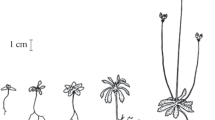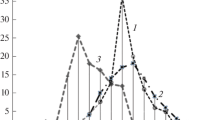Abstract
Graphical analysis was done on the lfie history evolution of biennials (or monocarpic perennials). The age of seed production (x), the probability of surviving to agex [l(x)], and the number of seeds produced at agex[b(x)] determine the ultimate rate of population increase (r). The ages whenr=max andr=0 define the optimal and critical age for seed production, respectively, which depend on the shape and combination of thel(x) andb(x) curves. The otpimal age of seed production appears only for the convex function of the natural logarithm of the net reproductive rate [R 0(x)], while the critical age appears irrespective of the shape of theR 0(x) curves. The effects of environmental change on the optimal and critical ages are, analyzed, with the conclusion that in an environment imposing higher mortality or lower fecundity, delayed reproduction is favored. Age- and size-dependent productions of seeds have different effects on the variation ofr in a changing environment.
Similar content being viewed by others
References
Baskin, J.M. andC.C. Baskin. 1979. Studies on the autoecology and population biology of the weedy monocarpic perennialPastinaca sativa. J. Ecol.67: 601–610.
Caswell, H. andP.A. Werner. 1978. Transient behavior and life history analysis of teasel (Dipsacus sylvestris Huds.). Ecology59: 53–66.
Charnov, W.L. andW.M. Schaffer. 1973. Life-history consequences of natural selection: Cole's results revisited. Amer. Nat.107: 791–793.
Cole, L.C. 1954. The population consequences of life history phenomena. Quar. Rev. Biol.29: 103–137.
Deevey, E.S., Jr. 1947. Life tables for natural populations of animals. Quar. Rev. Biol.22: 283–314.
Evans, G.C. 1972. The Quantitative Analysis of Plant Growth. Blackwell Scientific Publ., Oxford.
Gadgil, M. andW.H. Bossert. 1970. Life historical consequences of natural selection. Amer. Nat.104: 1–24.
Gross, K.L. 1981. Predictions of fate from rosette size in four “biennial” plant species:Verbascum thapsus, Oenothera biennis, Daucus carota, andTragopogon dubius. Oecologia48: 209–213.
Harper, J.L. 1977. Population Biology of Plants. Academic Press, London.
—. 1970. The shapes and sizes of seeds Ann. Rev. Ecol. Syst.1: 327–356.
— andJ. Ogden. 1970. The reproductive strategy of higher plants. I. The concept of strategy with special reference toSenecio vulgaris L. J. Ecol.58: 681–698.
—. 1974. The demography of plants. Ann. Rev. Ecol. Syst.5: 419–463.
Hart, R. 1977. Why are biennials so few? Amer. Nat.111: 792–799.
Hirose, T. andN. Kachi. 1982. Critical plant size for flowering in biennials with special reference to their distribution in a sand dune system. Oecologia55: 281–284.
Kawano, S. 1981. Trade-off relationships between some reproductive characteristics in plants with special reference to life history strategy. Bot. Mag. Tokyo94: 285–294.
— andS. Hayashi. 1977. Plasticity in growth and reproductive energy allocation ofCoix Ma-yuen Roman. cultivated at varying densities and nitrogen levels. J. Coll. Liberal Arts, Toyama Univ.10: 61–92.
Law, R. 1979. Ecological determinants in the evolution of life histories.In: R.M. Anderson,et al., ed., Population Dynamics, Symp. British Ecol. Soc.20: 81–103. Blackwell Scientific Publ., Oxford.
—. 1977. Life-history variation inPoa annua. Evolution31: 233–246.
Lotka, A. 1924. Elements of Physical Biology. Williams and Wilkins, Baltimore.
Meijden, E. van der andR.E. van der Waals-Kooi. 1979. The population ecology ofSenecio jacobaea in a sand dune system. I. Reproductive strategy and the biennial habit. J. Ecol.67: 131–153.
Mertz, D.B. 1970. Notes on methods used in life-history studies.In: J.H. Connellet al., ed., Readings in Ecology and Ecological Genetics p. 4–17. Harper and Row, New York.
Sarukhán, J. andJ.L. Harper. 1973. Studies on plant demography:Ranunculus repens L.,R. bulbosus L. andR. acris L. I. Population flux and survivorship. J. Ecol.61: 675–716.
Schaffer, W.M. 1974. Selection for optimal life histories: The effects of age structure. Ecology55: 291–303.
—. 1975. Selection for optimal life histories in plants.In: M.L. Cody and J.M. Diamond, ed., Ecology and Evolution of Communities p. 142–157. Harvard Univ. Press, Cambridge.
Smith, C.C. andS.D. Fretwell. 1974. The optimal balance between size and number of offspring. Amer. Nat.108: 499–506
Solbrig, O.T. 1980. Demography and natural selection.In: O.T. Solbrig, ed., Demography and Evolution in Plant Populations p. 1–20. Blackwell Scientific Publ., Oxford.
Stebbins, G.L. 1971. Adaptive radiation of reproductive characteristics in Angiosperms, II: Seeds and seedlings. Ann. Rev. Ecol. Syst.2: 237–260.
Watkinson, A.R. 1982. Factors affecting the density response ofVulpia fasciculata. J. Ecol.70: 149–161.
Werner, P.A. 1975. Predictions of fate from rosette size in teasel (Dipsacus fullonum L.). Oecologia20: 197–201.
—. 1977. Population growth rates and age versus stage-distribution models for teasel (Dipsacus sylvestris Huds.). Ecology58: 1103–1111.
Author information
Authors and Affiliations
Rights and permissions
About this article
Cite this article
Hirose, T. A graphical analysis of life history evolution in biennial plants. Bot Mag Tokyo 96, 37–47 (1983). https://doi.org/10.1007/BF02489573
Received:
Issue Date:
DOI: https://doi.org/10.1007/BF02489573




